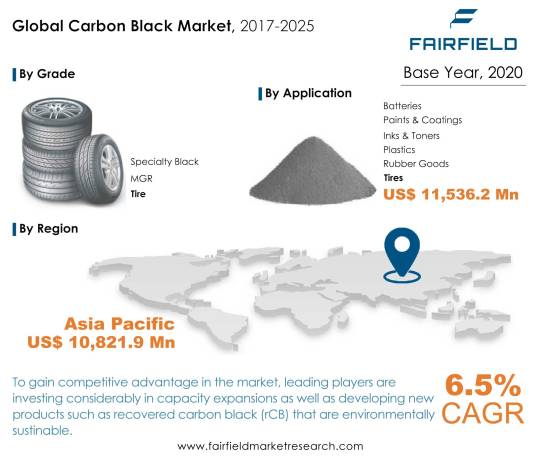#carbon black market
Explore tagged Tumblr posts
Photo




(via Global Carbon Black Market Size, Outlook 2024-2030)
0 notes
Text
Carbon Black Market Growth
Global Carbon Black Market Insights The global carbon black market, valued at USD 17.9 Billion in 2024, is projected to soar to USD 25.4 Billion by 2033 with a CAGR of 3.57% (2025-2033).
0 notes
Text

#Carbon Black Market#UAE Carbon Black Market#UAE Carbon Black Market Size#UAE Carbon Black Market Share
0 notes
Text
The global carbon black market is likely to showcase a growth of around 5% during the forecast period.
0 notes
Text
#Carbon Black Market#Carbon Black Market size#Carbon Black Market share#Carbon Black Market trends#Carbon Black Market analysis#Carbon Black Market forecast#Carbon Black Market outlook#Carbon Black Market overview#Carbon Black Market report
0 notes
Text
The global carbon black market is expected to reach US$ 22.65 billion by 2028. It is growing at a CAGR of 4.1% during the forecast period 2023-2028. The market is driven by increasing demand for carbon black in the automotive and construction industries. Carbon black is a form of elemental carbon produced by hydrocarbon incomplete combustion. It is widely used as a reinforcing agent in rubber and tire manufacturing, as well as in plastics, coatings, and other industrial applications.
0 notes
Text
Mexico Carbon Black Market Demand, Size and Growth Opportunity 2021-2025
The carbon black market in Mexico has become an integral part of the country's modern automotive culture, revolutionizing the performance and longevity of tires. With carbon black reinforcement, tires now have the capability to travel significantly more miles compared to older tires, resulting in increased durability and reduced frequency of replacements. This transformation in the automotive industry has contributed to the remarkable growth of the carbon black market, which was valued at US$17.4 billion in 2018 and is projected to reach US$23.6 billion by 2025, with a healthy compound annual growth rate (CAGR) of 6.5% between 2021 and 2025, according to a recent study conducted by Fairfield Market Research.

Access Full Report: https://www.fairfieldmarketresearch.com/report/carbon-black-market
Carbon black, a fine black powder composed of elemental carbon, is primarily manufactured through the partial combustion and pyrolysis of low-value oil residues derived from coal or crude oils. The furnace black process accounts for over 95% of carbon black production globally. Its versatile properties make it a vital element in the production of numerous products used in everyday life, particularly those requiring a strong and deep black color. Carbon black is commonly used as a reinforcement agent in rubber and non-rubber applications, as well as a pigment, conductive or insulating agent, rheology modifier, and UV stabilizer.
Tires represent a key consumer segment in the global carbon black market, with the tire industry alone accounting for over 70% of the global demand in 2019. In Mexico, the increasing disposable incomes and expanding economic activities have led to higher vehicle ownership rates and a surge in the demand for carbon black in the tire industry. The adoption of high-performance and premium tires, as well as tire pressure monitoring systems, has further bolstered this demand. Additionally, the growth of the transportation industry, including the rise of electric vehicles, shared transportation, and driverless technology, is expected to fuel the tire replacement market, providing lucrative opportunities for the carbon black market in Mexico.
Apart from tires, carbon black finds extensive usage in industrial rubber goods, including mechanical rubber goods (conveyor belts, hoses, gaskets, and seals) and automotive rubber parts (anti-vibration parts, sealant systems, wiper blades, and fascia). Specialty carbon black, a niche segment within the carbon black market, is witnessing significant growth due to its applications as a black pigmenting, conductive, and UV stabilizing agent in paints, printing ink toners, plastics, batteries, wires and cables, sealant systems, and solid carbons.
In Mexico, the dominance of the carbon black market is expected to continue in the Asia Pacific region, which accounted for over 60% of the global demand in 2019. The region benefits from lower production costs due to the availability of low-priced feedstock and lower labor rates. China, in particular, is the largest producer of carbon black globally, accounting for more than 40% of the total production.
While Europe is anticipated to exhibit stable demand for rubber and mechanical rubber goods carbon black, the region is experiencing rising demand for specialty carbon black, particularly in the form of conductive additives for paints, plastics, inks, and electric vehicle batteries. Specialty carbon black plays a crucial role in supporting the EU's "Smart and Sustainable Mobility Strategy," which aims to have 30 million electric vehicles on the roads by the end of the decade.
To meet sustainability goals and reduce greenhouse gas emissions, companies in the carbon black market are actively focusing on cleaner and renewable sources for production. Technological advancements and the integration of renewable energy into the production process are becoming key priorities for industry players. Monolith Materials, for example, has announced significant investments in its carbon black production, utilizing proprietary technology to convert natural gas into carbon black while reducing emissions by up to 1 million tons annually.
As the carbon black market continues to thrive and revolutionize the automotive industry, Mexico remains a significant player in this global phenomenon. With its strong demand for carbon black in tire manufacturing and the growing adoption of specialty carbon black, Mexico's market is poised for sustained growth and prosperity.
Web: https://www.fairfieldmarketresearch.com/Email: [email protected]
0 notes
Text
The carbon black market is expected to witness market growth at a rate of 6.15% in the forecast period of 2021 to 2028. Data Bridge Market Research report on carbon black market provides analysis and insights regarding the various factors expected to be prevalent throughout the forecast period while providing their impacts on the market’s growth. The rise in the adoption of advanced technologies in tire production is escalating the growth of carbon black market.
#Carbon Black Market#Carbon Black Market Demand#Carbon Black Market Share#Carbon Black Market Forecast#Carbon Black Market Trend#Carbon Black Market Segment#Carbon Black Market Overview#Carbon Black Market Growth
0 notes
Text
Carbon Black Market Growth
Global Carbon Black Market Trends The carbon black market reached USD17.9B in 2024 and is set to grow to USD25.4B by 2033, with a 3.57% CAGR! Key drivers: demand in tire & plastics manufacturing, booming construction, and eco-friendly production advancements.
0 notes
Text

#Carbon Black Market#Saudi Arabia Carbon Black Market#Saudi Arabia Carbon Black Market Size#Saudi Arabia Carbon Black Market Growth
0 notes
Text





James Spader as Mr. Black - Shorts (2009)
#james spader#mr black#carbon black#shorts#shorts movie#shorts 2009#mr carbon black#mister carbon black#carbon black gif#carbon black gifs#mr black gifs#shorts gif#shorts gifs#gif#gifs#gifset#it was time to make a gifset of my beloved mr carbon black again#i think he is my second fave spader chara right after reddington#i am in a red and mr black sandwich#that would be heaven fr guys#ugh#i looove hiiiiim#god i love the way how he holds himself and how he speaks <3333#cruel bussiness man who loves to dominate the market with his silly little boxes and loves money#and has a thing for being a giant robot kfjcjfjxj
40 notes
·
View notes
Text
Recovered Carbon Black (rCB) Market, Global Outlook and Forecast 2025-2032
Recovered Carbon Black (rCB) is a material derived from scrap tires through a process known as pyrolysis, where the tires are subjected to high heat in the absence of oxygen, breaking down the tires into various components, including carbon black. Carbon black is a fine, black powder primarily used as a reinforcing filler in rubber products, coatings, inks, and plastics. rCB typically contains 10-20% non-carbonaceous material and is free from wire and fabric.
The key appeal of recovered carbon black is its ability to offer a sustainable and cost-effective alternative to virgin carbon black. rCB’s reinforcing properties generally fall within the range of standard carbon black grades, particularly in the N500 to N700 series, which are widely used in tire manufacturing. The growing demand for environmentally-friendly products, coupled with the rising concerns over the carbon footprint of manufacturing processes, has led to a surge in the adoption of rCB in various industries, including automotive and packaging.
Download FREE Sample Report PDF : https://www.24chemicalresearch.com/download-sample/286779/global-recovered-carbon-black-forecast-market-2025-2032-561
Market Size
The global Recovered Carbon Black (rCB) market was valued at approximately USD 197.90 million in 2023. Projections suggest that this market is set to grow substantially, reaching USD 2419.90 million by 2032, demonstrating a remarkable compound annual growth rate (CAGR) of 43.00% during the forecast period.
The increasing demand for sustainable and environmentally responsible alternatives to traditional carbon black plays a pivotal role in driving market growth. Furthermore, the mounting global concern regarding tire waste and the need for more efficient recycling processes has resulted in higher investments in pyrolysis technology and infrastructure, fueling the market’s expansion.
Over the past few years, the rCB market has seen significant shifts, primarily due to the regulatory push toward sustainability and circular economy principles. With advancements in pyrolysis technology, rCB’s properties have improved, leading to its increased adoption across a variety of applications, including tire manufacturing, coatings, and plastics.
Market Dynamics
Drivers
Several factors are contributing to the rapid growth of the rCB market:
Sustainability and Environmental Regulations: Stringent environmental policies and the global push for a circular economy have made recycling and reusing materials more attractive. As industries strive to reduce their carbon footprint, rCB is becoming a viable, eco-friendly alternative to traditional carbon black.
Waste Management and Tire Recycling: The disposal of waste tires is a growing global concern. Pyrolysis-based recovery of carbon black from scrap tires offers a sustainable solution to this problem, making it highly attractive for businesses and governments.
Cost-Effectiveness: The cost of rCB is often lower than that of virgin carbon black, making it an appealing option for businesses aiming to reduce production costs while maintaining performance in products like tires and plastics.
Restraints
Despite the growth opportunities, certain challenges affect the rCB market:
Quality Control and Consistency: The quality of rCB can vary depending on the pyrolysis process, leading to inconsistencies in its reinforcing properties. Manufacturers must ensure stringent quality control to meet industry standards, which can increase operational costs.
High Initial Investment: Setting up pyrolysis plants and recycling facilities requires significant capital investment, which can be a barrier for smaller companies looking to enter the market.
Opportunities
The rCB market presents several growth opportunities:
Technological Advancements in Pyrolysis: Ongoing research into improving the efficiency of pyrolysis technology promises to enhance the quality and yield of recovered carbon black, making it more competitive with virgin materials.
Expansion into New Applications: With its versatility, rCB holds the potential to be used in more diverse applications beyond tires, such as in plastics, coatings, and inks, opening new avenues for growth.
Challenges
Competition with Virgin Carbon Black: While rCB offers sustainability advantages, it faces stiff competition from virgin carbon black, which still dominates most markets due to its established supply chains and performance consistency.
Regulatory Hurdles: The industry is subject to various regulations concerning the recycling and waste disposal of tires, which can create barriers for the smooth operation of rCB production plants.
Regional Analysis
The global rCB market has shown varied growth patterns depending on the region. North America and Europe are currently leading the market, driven by strong environmental regulations and a high degree of awareness regarding tire waste. However, emerging markets such as Asia-Pacific and South America are catching up due to the increasing adoption of recycling technologies and growing demand for sustainable products.
North America
North America holds a significant share of the global rCB market, valued at USD 51.57 million in 2023. This region is expected to witness a CAGR of 36.86% from 2025 to 2032, driven by strong demand from tire manufacturers and a rising shift toward environmentally-friendly products. The U.S. and Canada, in particular, are leading the way in investing in advanced pyrolysis technologies.
Europe
Europe’s rCB market is expanding due to stringent environmental laws and waste tire management policies. Countries like Germany, the UK, and France are heavily involved in recycling initiatives, creating a favorable market for rCB products.
Asia-Pacific
The Asia-Pacific region is expected to witness the highest growth rate in the rCB market. This can be attributed to increasing urbanization, rising automotive production, and greater awareness of recycling technologies in countries like China, Japan, and India.
South America
South America’s market is also poised for growth as tire waste management becomes a priority in countries like Brazil and Argentina, offering further market expansion for rCB producers.
Competitor Analysis
The Recovered Carbon Black (rCB) market is highly competitive, with several key players contributing to the overall market dynamics. These companies are investing in research and development to improve the quality of rCB and expand their product offerings. Some of the leading companies in the global rCB market include:
Pyrolyx
Delta-Energy Group
Black Bear Carbon
Scandinavian Enviro Systems AB
Klean Industries
Radhe Group of Energy
Alpha Carbone
Bolder Industries
DRON Industries
DVA Renewable Energy JSC
Enrestec
Integrated Resource Recovery
SR2O Holdings
Eneform
Doublestar Group
Carbon Recovery GmbH
Global Recovered Carbon Black (rCB) Market: Market Segmentation Analysis
This report provides a deep insight into the global Recovered Carbon Black (rCB) market, covering all its essential aspects. This ranges from a macro overview of the market to micro details of the market size, competitive landscape, development trend, niche market, key market drivers and challenges, SWOT analysis, value chain analysis, etc.
The analysis helps the reader to shape the competition within the industries and strategies for the competitive environment to enhance the potential profit. Furthermore, it provides a simple framework for evaluating and assessing the position of the business organization. The report structure also focuses on the competitive landscape of the Global Recovered Carbon Black (rCB). This report introduces in detail the market share, market performance, product situation, operation situation, etc., of the main players, which helps the readers in the industry to identify the main competitors and deeply understand the competition pattern of the market.
In a word, this report is a must-read for industry players, investors, researchers, consultants, business strategists, and all those who have any kind of stake or are planning to foray into the Recovered Carbon Black (rCB) market in any manner.
Market Segmentation (by Application)
Tire
Plastics
Coatings
Inks
Market Segmentation (by Type)
Primary Carbon Black
Inorganic Ash
Key Company
Pyrolyx
Delta-Energy Group
Black Bear Carbon
Scandinavian Enviro Systems AB
Klean Industries
Radhe Group of Energy
Alpha Carbone
Bolder Industries
DRON Industries
DVA Renewable Energy JSC
Enrestec
Integrated Resource Recovery
SR2O Holdings
Eneform
Doublestar Group
Carbon Recovery GmbH
Geographic Segmentation
North America (USA, Canada, Mexico)
Europe (Germany, UK, France, Russia, Italy, Rest of Europe)
Asia-Pacific (China, Japan, South Korea, India, Southeast Asia, Rest of Asia-Pacific)
South America (Brazil, Argentina, Columbia, Rest of South America)
The Middle East and Africa (Saudi Arabia, UAE, Egypt, Nigeria, South Africa, Rest of MEA)
FAQ
What is the current market size of the Recovered Carbon Black (rCB) market?
➣ The market was valued at approximately USD 197.90 million in 2023 and is projected to reach USD 2419.90 million by 2032, growing at a CAGR of 43.00% during the forecast period.
Which are the key companies operating in the Recovered Carbon Black (rCB) market?
➣ The key players in the market include Pyrolyx, Delta-Energy Group, Black Bear Carbon, Scandinavian Enviro Systems AB, Klean Industries, Radhe Group of Energy, and more.
What are the key growth drivers in the Recovered Carbon Black (rCB) market?
➣ The key drivers include the demand for sustainable alternatives, rising environmental concerns, regulatory push for recycling, and tire waste management.
Which regions dominate the Recovered Carbon Black (rCB) market?
➣ North America, Europe, and Asia-Pacific are the dominant regions, with North America leading in the adoption of advanced recycling technologies.
What are the emerging trends in the Recovered Carbon Black (rCB) market?
➣ Emerging trends include advancements in pyrolysis technology, increased adoption across new applications like plastics and coatings, and a growing focus on sustainability.
Key Benefits of This Market Research:
Industry drivers, restraints, and opportunities covered in the study
Neutral perspective on the market performance
Recent industry trends and developments
Competitive landscape & strategies of key players
Potential & niche segments and regions exhibiting promising growth covered
Historical, current, and projected market size, in terms of value
In-depth analysis of the Recovered Carbon Black (rCB) Market
Overview of the regional outlook of the Recovered Carbon Black (rCB) Market:
Key Reasons to Buy this Report:
Access to date statistics compiled by our researchers. These provide you with historical and forecast data, which is analyzed to tell you why your market is set to change
This enables you to anticipate market changes to remain ahead of your competitors
You will be able to copy data from the Excel spreadsheet straight into your marketing plans, business presentations, or other strategic documents
The concise analysis, clear graph, and table format will enable you to pinpoint the information you require quickly
Provision of market value (USD Billion) data for each segment and sub-segment
Indicates the region and segment that is expected to witness the fastest growth as well as to dominate the market
Analysis by geography highlighting the consumption of the product/service in the region as well as indicating the factors that are affecting the market within each region
Competitive landscape which incorporates the market ranking of the major players, along with new service/product launches, partnerships, business expansions, and acquisitions in the past five years of companies profiled
Extensive company profiles comprising of company overview, company insights, product benchmarking, and SWOT analysis for the major market players
The current as well as the future market outlook of the industry concerning recent developments which involve growth opportunities and drivers as well as challenges and restraints of both emerging as well as developed regions
Includes in-depth analysis of the market from various perspectives through Porter’s five forces analysis
Provides insight into the market through Value Chain
Market dynamics scenario, along with growth opportunities of the market in the years to come
6-month post-sales analyst support
Download FREE Sample Report PDF : https://www.24chemicalresearch.com/download-sample/286779/global-recovered-carbon-black-forecast-market-2025-2032-561
0 notes
Text
Recovered Carbon Black Market to Hit $2373.6 Million by 2032
The global Recovered Carbon Black Market was valued at USD 105.1 Million in 2024 and it is estimated to garner USD 2373.6 Million by 2032 with a registered CAGR of 56.1% during the forecast period 2024 to 2032.
The report throws light on the competitive scenario of the global Recovered Carbon Black Market to know the competition at global levels. Market experts also provided the outline of each leading player of the global Recovered Carbon Black Market for the market, considering the key aspects such as the areas of operation, production, and product portfolio. In addition, the companies in the report are studied based on vital factors such as company size, market share, market growth, revenue, production volume, and profit.
The global Recovered Carbon Black Market is fragmented with various key players. Some of the key players identified across the value chain of the global Recovered Carbon Black Market include Black Bear Carbon B.V., Bolder Industries, ENRESTEC, Klean Carbon, Radhe Group Of Energy, Scandinavian Enviro Systems AB, SR2O Holdings, LLC Delta Energy LLC etc. Considering the increasing demand from global markets various new entries are expected in the Recovered Carbon Black Market at regional as well as global levels.
Download Recovered Carbon Black Market Sample Report PDF: https://www.vantagemarketresearch.com/recovered-carbon-black-market-2155/request-sample
Top Competitors:
Black Bear Carbon B.V., Bolder Industries, ENRESTEC, Klean Carbon, Radhe Group Of Energy, Scandinavian Enviro Systems AB, SR2O Holdings, LLC Delta Energy LLC
Understanding the Industry's Growth, has released an Updated report on the Recovered Carbon Black Market. The report is mixed with crucial market insights that will support the clients to make the right business decisions. This research will help new players in the global Recovered Carbon Black Market to sort out and study market needs, market size, and competition. The report provides information on the supply and market situation, the competitive situation and the challenges to the market growth, the market opportunities, and the threats faced by the major players.
Regional Analysis
-North America [United States, Canada, Mexico]
-South America [Brazil, Argentina, Columbia, Chile, Peru]
-Europe [Germany, UK, France, Italy, Russia, Spain, Netherlands, Turkey, Switzerland]
-Middle East & Africa [GCC, North Africa, South Africa]
-Asia-Pacific [China, Southeast Asia, India, Japan, Korea, Western Asia]
You Can Buy This Report From Here: https://www.vantagemarketresearch.com/buy-now/recovered-carbon-black-market-2155/0
Full Analysis Of The Recovered Carbon Black Market:
Key findings and recommendations point to vital progressive industry trends in the global Recovered Carbon Black Market, empowering players to improve effective long-term policies.
The report makes a full analysis of the factors driving the development of the market.
Analyzing the market opportunities for stakeholders by categorizing the high-growth divisions of the market.
Questions answered in the report
-Who are the top five players in the global Recovered Carbon Black Market?
-How will the global Recovered Carbon Black Market change in the next five years?
-Which product and application will take the lion's share of the global Recovered Carbon Black Market?
-What are the drivers and restraints of the global Recovered Carbon Black Market?
-Which regional market will show the highest growth?
-What will be the CAGR and size of the global Recovered Carbon Black Market during the forecast period?
Read Full Research Report with [TOC] @ https://www.vantagemarketresearch.com/industry-report/recovered-carbon-black-market-2155
Reasons to Purchase this Recovered Carbon Black Market Report:
-Analysis of the market outlook on current trends and SWOT analysis.
-The geographic and country level is designed to integrate the supply and demand organizations that drive industry growth.
-Recovered Carbon Black Industry dynamics along with market growth opportunities in the coming years.
-Recovered Carbon Black Market value (million USD) and volume (million units) data for each segment and sub-segment.
1 year consulting for analysts along with development data support in Excel. Competitive landscape including market share of major players along with various projects and strategies adopted by players in the last five years.
Market segmentation analysis including qualitative and quantitative analysis including the impact on financial and non-economic aspects.
Complete company profiles that include performance presentations, key financial overviews, current developments, SWOT analyzes and strategies used by major Recovered Carbon Black Market players.
Check Out More Reports
Global Infectious Disease Diagnostics Market: Report Forecast by 2032
Global Sand Control Solutions Market: Report Forecast by 2032
Global Marché des médicaments sur ordonnance: Report Forecast by 2032
Global Micro Fulfillment Market: Report Forecast by 2032
Global Tissue Paper Market: Report Forecast by 2032
#Recovered Carbon Black Market#Recovered Carbon Black Market 2024#Global Recovered Carbon Black Market#Recovered Carbon Black Market outlook#Recovered Carbon Black Market Trend#Recovered Carbon Black Market Size & Share#Recovered Carbon Black Market Forecast#Recovered Carbon Black Market Demand#Recovered Carbon Black Market sales & price
0 notes